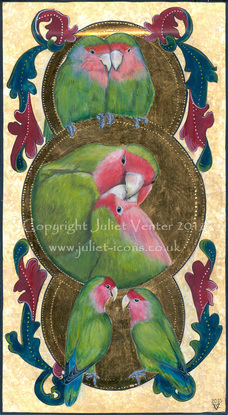|
It is a typical damp and blowy English bank holiday Monday, so here are some imaginary birds to cheer the scene.
 Cathedral of Holy Wisdom Constantinople Cathedral of Holy Wisdom Constantinople The unfamiliar translation of the Old Testament lesson today opened my ears to an expanded meaning of Proverbs 8, which prefigures the presence of the Son in the creation of the world. "The Wisdom of God cries aloud:.... I was by his side, a master craftsman, delighting him day after day, ever at play in his presence, at play everywhere in his world, delighting to be with the sons of men." Creative activity is holy, even if it goes unrecognised and unrewarded in a worldly way. If you are feeling guilty about spending time on your artistic endeavours, remember such 'playing' gives us an opportunity to mimic Christ. Less productivity, more play! This is a not-to-be-missed opportunity to see illuminated treasures from many centuries and cultures at the Fitzwilliam Museum in Cambridge. Fortunately there is plenty of time, as the exhibition runs from 30 July to December this year. It is entitled Colour: the art and science of illuminated manuscripts, and is part of the university's manuscript research and cataloguing project that has been going on for some years now. Cambridge University as a whole has a magnificent collection of illuminated manuscripts scattered through the college and University libraries, but unless you are a senior university member or can offer bona fides from a serious academic institution elsewhere you are unlikely to get a chance to handle and really be intimate with any of the great treasures. Looking at them dimly lit behind glass is frankly not the same, but is still a wonderful opportunity for study, if only to realise how very tiny much of the work is. Reproductions in books tend to be very much enlarged, and one gets no sense of the absolutely diminutive scale these artists worked on. Either serious myopia was a job requirement and these artists were blind as moles more than six inches from their noses (as I am myself) or else magnifying eyewear was more common in the middle ages than is generally thought. Someone ought to make a study of the role of myopia in art - I'm convinced it must have played a part in Impressionism as well.
There are only two female doctors of the (Catholic) church, St Teresa of Avila and St Catherine of Siena. Why so few are honoured is another of the eternal mysteries, but in fact these two ladies gave me quite enough trouble by themselves and the work took far longer than I budgeted for. Sometimes things just don't go smoothly. No more niche icons and fancy gilding for a while, it's time to simplify. I mounted the pair on my sale page today (see them here). I am planning icons of Jesuit saints now and think to do without gilding entirely, in the style of the Romanesque retables I saw at the Museo Catalunya in Barcelona.
Painting in the garden all day, praise be. Saints and dragons and pot plants getting an airing. Nothing so rare and precious as a perfect English day in May!
The dreadful looking mess in the top right photo is the 'proplasmos' layer of sample painted according to the Prosopon School of Iconology technique. Prosopon was founded by a Russian emigre in New York, and I recently attended a little workshop given to members of the British Association of Iconographers by Irina Bradley, Buckinghamshire-based Grand Master: you can visit her website at http://www.irinabradley.com/index.html. Proplasmos is the primal soup (or in the English translation 'chaos') from which God began the work of creation. We were copying a detail of Irina's own icon of the heavenly Jerusalem, pictured left. The technique relies on a textural sub-layer, created with gritty pigments in a very dilute suspension applied wet in small pools - as the pools dry they leave mottles and swirls on the surface of the gesso, exploiting the natural tendency of different weight crystals to separate out. When the proplasmos layer is dry, the large crystals are scraped off with a palette knife. This underlayer is then modified by many successive scumbles and glazes, ending with the characteristic abstract white highlights. Picture 2 shows the colours intensified and some rough delineation of the forms, picture 3 some quick highlights in white to demonstrate the next stage. A finished icon painted by this technique can have twenty or thirty transparent layers which produce a lively, even busy, visual effect. On the whole not a technique for the the control freak.
|
The view from my deskCurrent work, places and events, art travel, and interesting snippets about Christian icons, medieval art, manuscript illumination, egg tempera,, gilding, technique and materials. Categories
All
Archives
January 2024
|











 RSS Feed
RSS Feed